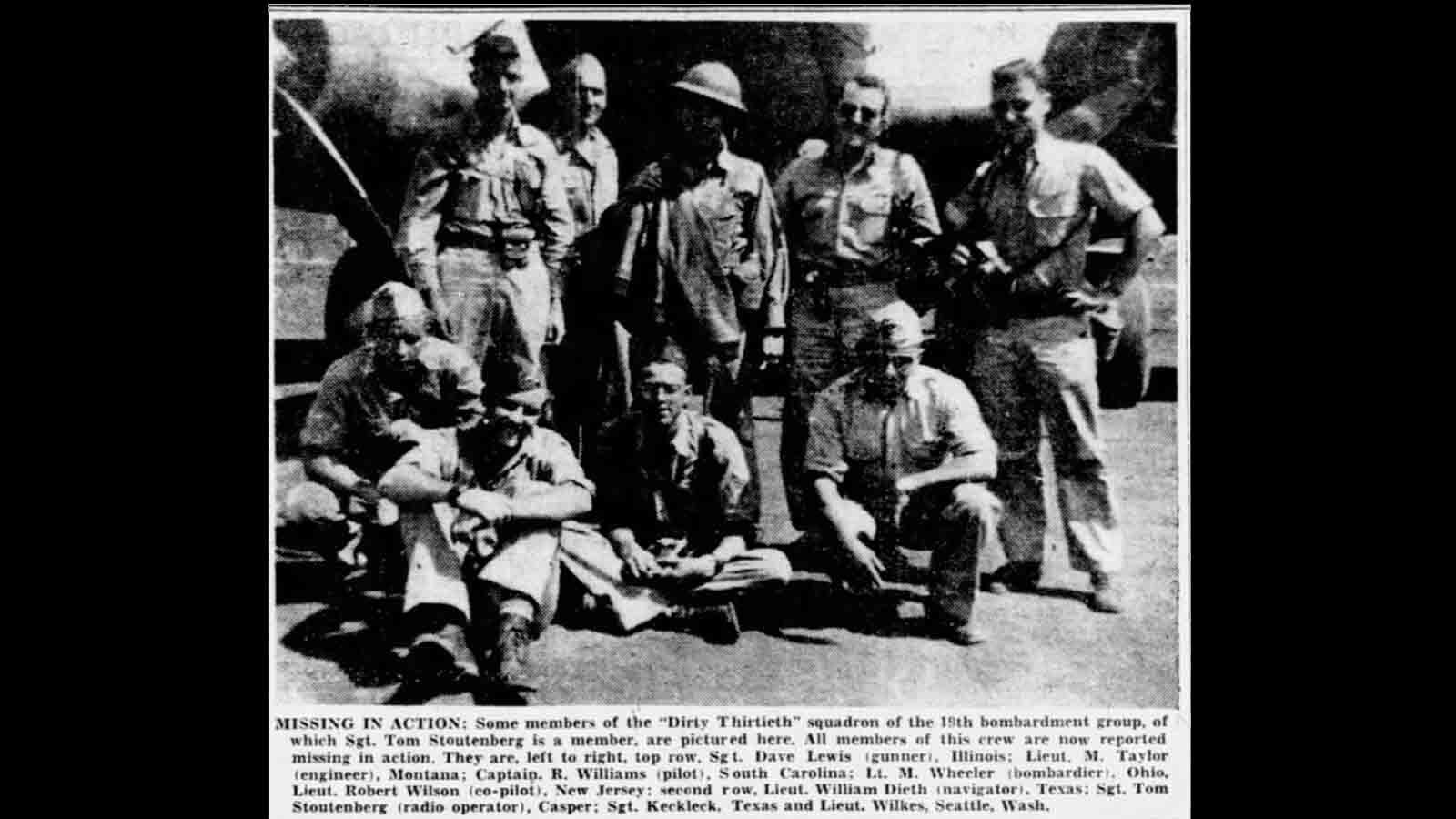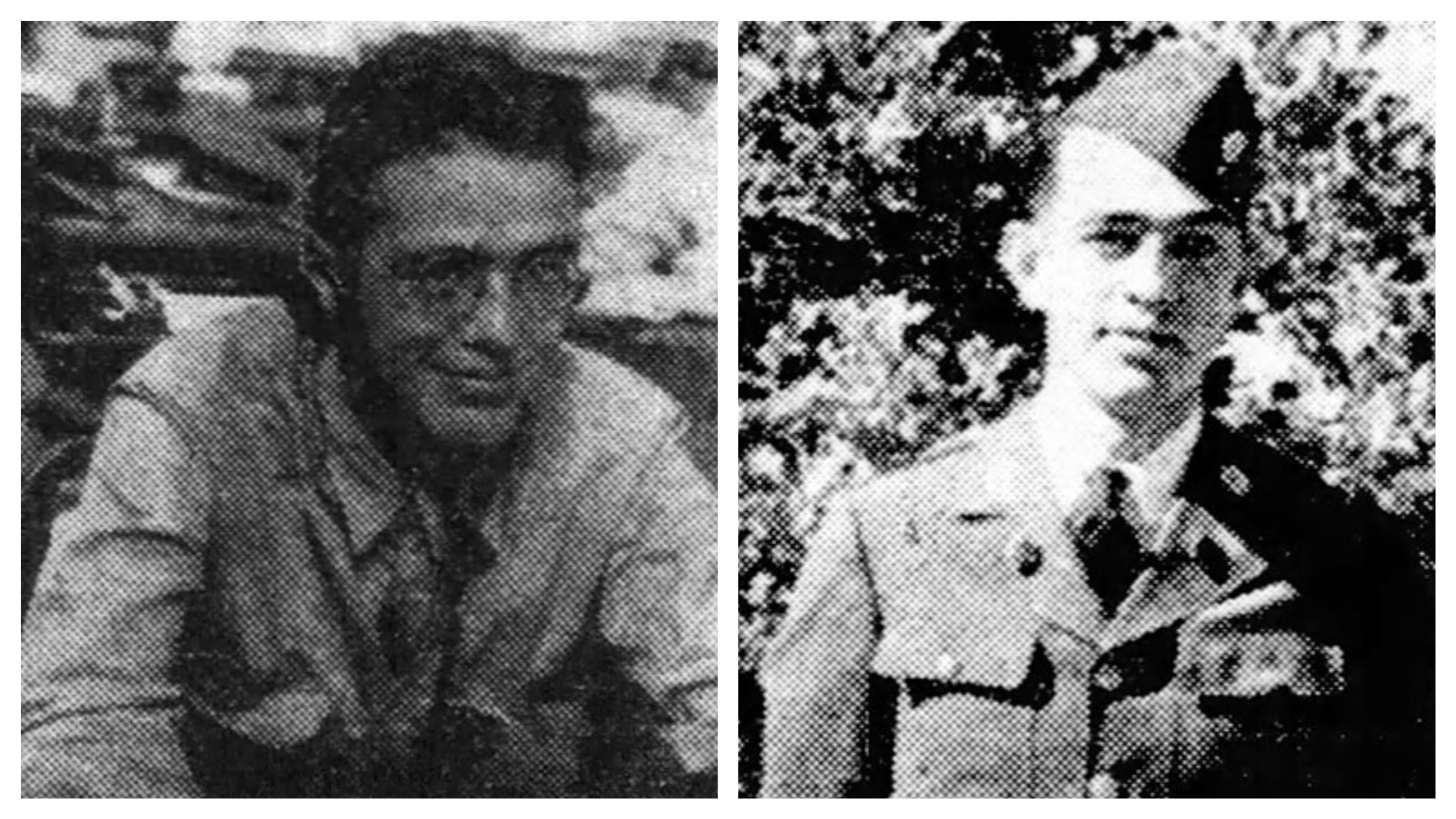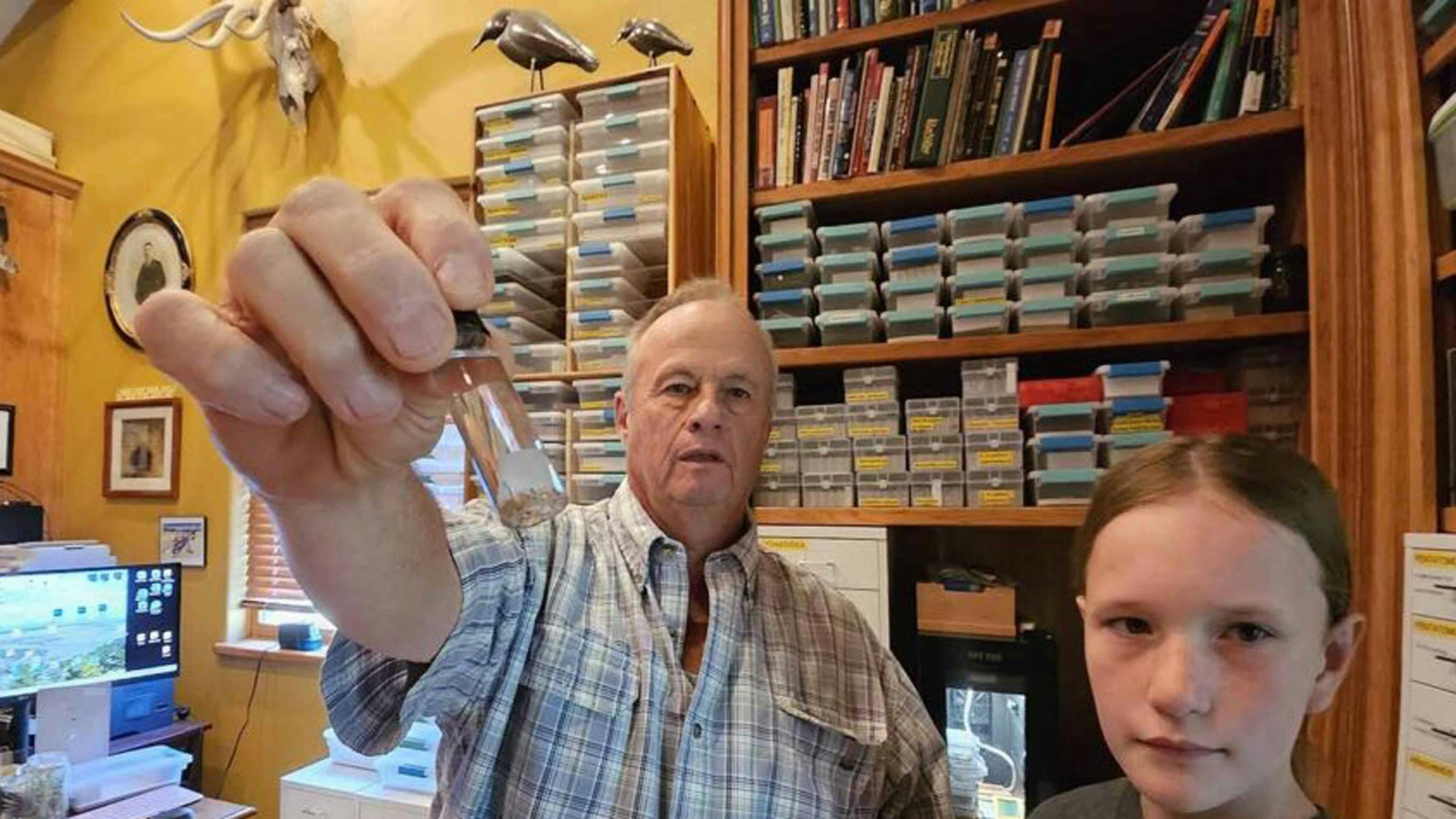Before Wyoming World War II hero Sgt. Thomas L. Cotner left to serve in the Pacific, his mother hosted a dinner party at Club La Vida in Evansville, a restaurant and night club known for its roulette wheel.
The event was noteworthy enough to earn coverage in the local newspaper, which reported the dinner was to honor Tom, who had just finished training at an air base in Illinois.
Tom’s brother and fraternal twin, Ted Cotner, was also in the Army Air Corps and would be stationed at Hickam Field in Hawaii, where on Dec. 7, 1941, he saw his first action.
Ted Cotner’s commander praised the young airman for his heroic response to the Pearl Harbor attack.
The Cotner boys were born in Worland, but moved to Casper where some friends and neighbors knew them by their stepfather’s last name: Stoutenburg.
Tom deployed to the Pacific and joined the vicious fighting in and over New Guinea, earning recognition for bravery in August 1942. A month later, he and the other eight members of his B-17 Flying Fortress crew disappeared.
The Casper Star-Tribune captured the anguish of the moment on Oct. 14, 1942, reporting, "Word was received in Casper on Monday night from the War Department that Sergeant Tom Stoutenberg, son of Mr. and Mrs. Emma Stoutenberg, is reported missing in action since September 16th. No details were contained in the message."
The paper noted that Tom was "on duty somewhere in the southwest Pacific battle zone" when he disappeared. Further coverage from April 1943 showed a photograph of Tom sitting with members of his unit, the notorious Dirty 30th Squadron of the 19th Bombardment Group.
Eight decades later, wreckage of the B-17 Flying Fortress where Tom served as a radio operator and gunner was identified high in the jungle by an investigator named Justin Taylan.

The Researcher
Taylan founded the nonprofit pacificwrecks.com and this week he shared his deep dive into Tom’s life, service and the apparent plane crash that caused him to go missing for 81 years.
A researcher originally from upstate New York who specializes in searching for missing warriors across the Pacific, Taylan was already in Papua New Guinea in 2023 working on another missing aircraft case.
That’s when a plane was discovered by a logging company cutting down trees and building a road through a remote forested area deep in the mountains of New Britain Island.
“This plane was discovered by accident and some pictures were posted online," Taylan said. "I saw them and realized, ‘Oh my God, this is an American airplane. It's a B-17.'"
The discovery site is in a moss-covered mountain forest so remote and elevated that even in the tropics, "Your breath forms condensation. And it's chilly, even in a tropical area that's quite high."
Within a month of seeing those initial photographs, Taylan made his way to the crash site, where he confirmed the identity of the plane from the serial number.
“And that's how we know what crew it is,” Taylan explained.
Describing what the wreckage and crash site looked like, Taylan said there was nothing to identify the nine crew members who likely died in the crash.
"There were remains in the open that I saw, but these are from an airplane crash. In World War II, it was a violent thing,” he said. “We're not talking about a complete skeleton, but rather bone fragments from where 80 years have left human remains. I have no doubt that most or all of the crew died in this plane."
Building on the aircraft's serial number, Taylan puzzled together an account of Tom’s final mission. His research revealed that on Sept. 15, 1942, seven B-17s took off from Mareeba Airfield, where Tom was stationed.
Mareeba housed both heavy bomber and fighter squadrons. The troops referred to it as Hoevet Field in honor of Major Dean Carol "Pinky" Hoevet who was killed exactly a month before Tom’s final mission.
The squadron staged at an airfield called 7 Mile Drome in New Guinea. Each Flying Fortress was loaded with four 500-pound bombs for "a night bombing mission against the Japanese occupied target called Rabaul,” according to pacificwrecks.com.
The Mission
The mission: Destroy the Vunakanau Airfield with the secondary target of Lakunai Airfield.
Vunakanau was part of a massive military complex that was developed into a major fleet base by the Japanese, eventually becoming the most heavily defended Japanese position in the South Pacific.
Its strategic location and large natural harbor made it the ideal staging base for ships, aircraft, troops and supplies during the New Guinea and Guadalcanal campaigns
So the target was no minor outpost. Vunakanau Airfield and the surrounding Rabaul area was defended by 367 anti-aircraft weapons.
At its peak, 97,000 Japanese personnel were stationed in and around what Allied intelligence considered "the most heavily defended target in the South-West Pacific Area,” according to pacificwrecks.com.
At that early stage of the war, American forces were vastly outnumbered and desperately trying to stem Japanese advances.
"The United States didn't have hundreds of airplanes. They had six, eight, 10, 12 was a big raid," Taylan said. Each bomber sent against Rabaul represented a significant portion of America's limited air power in the Pacific.
The mission was perilous by design, made worse by bad weather that September night.
According to mission records, "The weather was extremely bad with rain, lightning and thunderstorms and no moon" — conditions so severe that of the seven B-17s that launched, only two would reach their target. The bombers flew individually through enemy territory in radio silence.
"This plane was on a night mission. It was armed with bombs. It was a combat mission, and it failed to return," Taylan said.
Exactly what happened that September night remained a mystery for 81 years.
“This plane was never heard from after takeoff. We know now, based on where it crashed, that it reached the target and likely bombed and probably was lost returning from the mission in bad weather,” said Taylan.
The bombing runs, while "realistically a nuisance raid as far as the Japanese were concerned," sometimes achieved visible results: "explosions that could be seen,” reports Pacific Wrecks.
Tom Was Already A Hero
Taylan's investigation into Tom’s experience revealed a young man thrust into the war's most dangerous early campaigns.
Tom represented "a part of World War II where the United States entered the war and was very much on the ropes," he said.
Trained to protect the B-17 with the .50-caliber guns mounted in four turrets, Tom had already proven himself in combat, earning the Silver Star for his actions during a daylight mission in August 1942, when his formation was "engaged by enemy aircraft, claims were made for enemy shot down and damage inflicted,” according to Pacific Wrecks.
Then came his last mission a month later, and a couple more news reports for the folks back home, left wondering what happened to their buddy with two last names.
In 1943, under a photo of Tom and his squadron mates, the caption read "Missing in Action.”
From there, Tom’s story started to fade from public view.
His brother Ted returned from war and became a pressman, working for newspapers in Oregon. He died in 2005.
Then along came Taylan, who regrets not finding the crash site while Ted was still alive.
“From a genetic standpoint, the DNA identification thing, this work of identifying remains of a fraternal twin,” said Taylan, explaining that Ted, “Would have the same DNA as the deceased, so he would be a perfect match to identify his fraternal twin brother.
"Most Americans know the phrase ‘no man left behind’ or believe that the government, the military does everything in their power to find and identify missing in action cases.”
While that mission exists officially, "The reality is they're so inundated with tasks worldwide” that chasing down clues about a single missing B-17 and preserving the wreckage is one of many cases that needs more investigation.
"The longer that this plane is left, pieces may be removed from it by locals. Things will happen,” said Taylan, adding, "If this were my relatives — my uncle, my father, grandfather — I would sure want something done quickly."
Honoring The Fallen
Back in Wyoming, Tom Cotner’s story resonates deeply with those dedicated to honoring the state’s veterans.
Dean Welch, the American Legion Post 2 adjutant in Casper, told Cowboy State Daily he doesn’t hear many stories like Tom’s while volunteering for a variety of veterans’ causes, including the Wyoming Fallen Veterans Memorial.
The memorial contains "panels, and we have the name of every person from Wyoming since the Spanish-American War on those panels,” he said.
Welch continued, "Anything we can do to recognize" those who "gave the ultimate price for their country. We need to make sure that you're recognized for that.”
Tim Sheppard, executive director of the Wyoming Veterans Commission and a retired Army colonel, sees Tom’s story as part of a larger narrative essential to American identity.
"There's thousands of untold stories that I think would move people," he said. "And I think it also gives you an appreciation for who we are as a nation. We've had people who were willing to sacrifice to the degree and to be as heroic as they were. I think it really helps set the stage, especially for a younger audience, to carry the torch forward.”
For Taylan, each recovered story represents both an ending and a beginning. His work connects families to relatives they may have never known, while urging authorities to act on cases that might otherwise languish indefinitely.
He said, "In the end, this is information and pictures about something that will impact nine families in the United States. And sadly, if it wasn't for our outreach to locate them, perhaps some of these families may never be aware of this discovery.”
For the family of Staff Sgt. Marion Taylor of Billings, Montana, the discovery in New Guinea closed a chapter that included family members traveling to the Pacific back in the 1980s hoping to find answers.
“We had always heard he was lost in the ocean,” said Joanna Howard, Taylor’s grandniece. She told Cowboy State Daily, “I grew up hearing the stories. We’ve always wanted to bring him home.”
Howard remembers seeing her grandmother cry about her lost brother Marion and tell stories at the dinner table. They have a letter from Sept. 14, 1942, the day before the crash.
“And to read those letters,” said Howard. “It just means so much to bring that closure.”

What Remains
After Dean Welch heard about the wreckage discovery in New Guinea and the details emerging about Casper's own Tom Cotner, aka Tom Stoutenberg, he drove across town to the memorial he helped build.
The Fallen Veterans Memorial at 3800 W. 13th Street in Casper displays the names of more than 1,670 Wyoming soldiers who died or disappeared in combat.
Welch helped spearhead efforts to raise the wall, securing a $30,000 grant from AARP.
Standing before the panels, Welch confirmed for Cowboy State Daily that Tom’s name is there — Thomas L. Cotner — remembered among Wyoming's fallen.
The world young Tom left behind has long since changed. Club La Vida caught fire in March of 1943, and the flames destroyed its prized gambling room.
The address where Tom reportedly lived with his mother, brother and stepfather (155 N. Kimball Street in Casper) now appears to be a parking lot for a tax preparation service called Eagles Soaring.
But the name Thomas L. Cotner enlisted under endures on the memorial wall in Casper, alongside others with names worth remembering.
"The old saying is that a man dies twice," Welch told Cowboy State Daily in 2022 while working to make the Casper memorial wall a reality. "He dies once when he stopped breathing, and a second time when people stop saying his name."
David Madison can be reached at david@cowboystatedaily.com.











